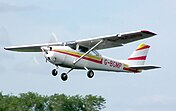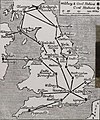Portal:Aviation
| Main page | Categories & Main topics |
|
Tasks and Projects |
The Aviation Portal

Aviation includes the activities surrounding mechanical flight and the aircraft industry. Aircraft includes fixed-wing and rotary-wing types, morphable wings, wing-less lifting bodies, as well as lighter-than-air craft such as hot air balloons and airships.
Aviation began in the 18th century with the development of the hot air balloon, an apparatus capable of atmospheric displacement through buoyancy. Some of the most significant advancements in aviation technology came with the controlled gliding flying of Otto Lilienthal in 1896; then a large step in significance came with the construction of the first powered airplane by the Wright brothers in the early 1900s. Since that time, aviation has been technologically revolutionized by the introduction of the jet which permitted a major form of transport throughout the world. (Full article...)
Selected article

Selected image
Did you know
...that the pioneer American airman Lowell Smith participated in the first mid-air refueling, the first aerial circumnavigation and held 16 records for military aircraft in speed, endurance and distance? ...that PWS-10 designed in late 1920s was the first Polish fighter to enter serial production?
- ... that the crash of an Australian National Airways Stinson in 1945 was believed by investigators to be the first in-flight structural failure attributable to metal fatigue?
General images -
In the news
- May 29: Austrian Airlines cancels Moscow-bound flight after Russia refuses a reroute outside Belarusian airspace
- August 8: Passenger flight crashes upon landing at Calicut airport in India
- June 4: Power firm helicopter strikes cables, crashes near Fairfield, California
- January 29: Former basketball player Kobe Bryant dies in helicopter crash, aged 41
- January 13: Iran admits downing Ukrainian jet, cites 'human error'
- January 10: Fire erupts in parking structure at Sola Airport, Norway
- October 27: US announces restrictions on flying to Cuba
- October 3: World War II era plane crashes in Connecticut, US, killing at least seven
- September 10: Nevada prop plane crash near Las Vegas leaves two dead, three injured
- August 6: French inventor Franky Zapata successfully crosses English Channel on jet-powered hoverboard
Related portals
Associated Wikimedia
The following Wikimedia Foundation sister projects provide more on this subject:
-
Commons
Free media repository -
Wikibooks
Free textbooks and manuals -
Wikidata
Free knowledge base -
Wikinews
Free-content news -
Wikiquote
Collection of quotations -
Wikisource
Free-content library -
Wikiversity
Free learning tools -
Wikivoyage
Free travel guide -
Wiktionary
Dictionary and thesaurus
Selected biography

The Reverend John Flynn (25 November 1880 – 5 May 1951) was an Australian Presbyterian minister and aviator who founded the Royal Flying Doctor Service, the world's first air ambulance.
Throughout his ministerial training, Flynn had worked in various then-remote areas through Victoria and South Australia. As well as tending to matters spiritual, Flynn quickly established the need for medical care for residents of the vast Australian outback, and established a number of bush hospitals. By 1917, Flynn was already considering the possibility of new technology, such as radio and the aeroplane, to assist in providing a more useful acute medical service, and then received a letter from an Australian pilot serving in World War I, Clifford Peel, who had heard of Flynn's speculations and outlined the capabilities and costs of then-available planes. Flynn turned his considerable fund-raising talents to the task of establishing a flying medical service.
The first flight of the Aerial Medical Service was in 1928 from Cloncurry. In 1934 the Australian Aerial Medical Service was formed, and gradually established a network of bases nationwide. Flynn remained the public face of the organisation (through name changes to its present form) and helped raise the funds that kept the service operating.
Selected Aircraft
[[File:|right|250px|]] The Tupolev TB-3 (Russian: Тяжёлый Бомбардировщик, Tyazholy Bombardirovschik, Heavy Bomber, civilian designation ANT-6) was a heavy bomber aircraft which was deployed by the Soviet Air Force in the 1930s and during World War II. It was the world's first cantilever wing four-engine heavy bomber. Despite obsolescence and being officially withdrawn from service in 1939, TB-3 performed bomber and transport duties through much of WWII. The TB-3 also saw combat as a Zveno project fighter mothership and as a light tank transport.
- Span: 41.80 m (137 ft 2 in)
- Length: 24.4 m (80 ft 1 in)
- Height: 8.50 m (27 ft 11 in)
- Engines: 4× Mikulin M-17F V12 engines, 525 kW (705 hp) each
- Maximum Speed: 196 km/h (106 knots, 122 mph) at 3000 m (9,840 ft)
- First Flight: 22 December 1930
Today in Aviation
- 2009 – A Tupolev Tu-142 of the Russian Navy’s Pacific Fleet crashes in the Tatar Strait some 12 miles (19 km) off Sakhalin Island. All eleven crew are missing, presumed dead.
- 2007 – Romanian Air Force IAR-330 SOCAT attack helicopter belonging to the 90th Airlift Base crashed in Ungheni, 30 km south of Piteşti, Argeş county, southern Romania. Immediately after touching the ground, the aircraft exploded, as it was already on fire. All three crew members aboard were killed, including Commander Nicolae Bucur, who was one of the most experienced pilots of the Romanian Air Force, with over 2,700 flying hours.
- 2006 – FedEx announces the first cancellation of the Airbus A380. Instead FedEx orders 15 Boeing 777 Freighters.
- 2003 – UH-60L Black Hawk 92-26413 (or 92-26431) from 5–101 Aviation Regiment shot down by a MANPAD near Tikrit; all four crew, and both passengers from the Department of the Army are killed.[1]
- 2001 – The supersonic commercial aircraft Concorde resumes flying after a 15-month hiatus.
- 1996 – A Nigerian Boeing 727 crashes into a lagoon 40 miles southeast of Lagos, killing 143.
- 1981 – United States Navy Lockheed S-3 Viking from the USS Nimitz, is lost near Sardinia with all four aviators killed.
- 1978 – USN Douglas A-4F Skyhawk Blue Angel, BuNo 155056, during pre-show exhibition at NAS Miramar, San Diego, California, pilot, Lt. Mike Curtain (sp?-Curtin?), dead on impact, no ejection.
- 1976 – The first non-stop trans-Canada flight by jet fighters was carried out by two 434 Squadron CF-5 s using mid-air refueling.
- 1976 – First flight of the Dassault Falcon 50 F-WAMD
- 1971 – A USAF McDonnell Douglas F-4 Phantom II and a USAF Convair F-106A-130-CO Delta Dart, 59-0125, of the 84th Fighter-Interceptor Squadron, Hamilton AFB, California, suffer mid-air and crash in isolated areas near Nellis AFB, Nevada. All three crew eject and survive. F-4 crew, Maj. Henry J. Viccellio and Maj. James A. Robertson, okay. Phantom comes down 35 miles from Caliente, Nevada, Delta Dart attempts recovery to Nellis but pilot Maj. Clifford L. Lowrey ejects eight miles NE of base.
- 1966 – First flight of the Pilatus PC-11
- 1956 – In the Hummelfjell Accident, a Braathens SAFE de Havilland Heron with 12 on board crashes into Hummelfjell mountain near Tolga, Norway, killing the pilot and a passenger.
- 1954 – Soviet Air Force MiG-15 s shoot down a USAF B-29 Superfortress off Hokkaidō, claiming it was spying.
- 1950 – BOAC retires its last flying boat airliner from service.
- 1948 – Second prototype Republic XR-12 Rainbow, 44-91003, crashes at 1300 hrs. while returning to Eglin Air Force Base, Florida. The number 2 (port inner) engine exploded as the aircraft was returning from a photographic suitability test flight. The pilot was unable to maintain control due to violent buffeting, and he ordered the crew to bail out. Five of the seven crew escaped safely, including pilot Lynn Hendrix, rescued by Eglin crash boats and helicopters. Airframe impacts two miles S of the base, in the Choctawhatchee Bay. Sgt. Vernon B. Palmer, 20, and M/Sgt. Victor C. Riberdy, 30, who lived at Auxiliary Field 5, but was from Hartford, Connecticut, are KWF.
- 1945 – Gp Cpt H. J. Wilson sets a new official airspeed record of 606 mph (976 km/h) in a Gloster Meteor. Unofficial German speed records by the rocket-powered Messerschmitt Me 163 during the war had already exceeded 625 mph (1,000 km/h)
- 1942 – Nos. 427, 428 and 429 (Bomber) Squadrons were formed in England.
- 1942 – A U. S. Army Air Forces bomber discovers that Japanese forces are occupying Attu in the Aleutian Islands. American aircraft soon begin a bombing campaign against Attu.
- 1941 – (Overnight) – 392 British bombers attack Berlin, Cologne, and Mannheim, losing 36 of their number – A heavy 9.2 percent loss rate.
- 1936 – Polish Lotnictwo Wojskowe PZL.30 Żubr ("Bison") prototype, a twin-engine bomber design modified from a transport rejected in favour of Douglas DC-2s by LOT Polish Airlines, disintegrates in mid-air when wing structure fails. First flown in March 1936, the uninspired composite design of metal, wood and fabric was the first twin-engined bomber of home design to leave the ground, powered by 680 hp (510 kW) P.Z.L. (Bristol) Pegasus radials, but only 16 Żubrs were completed, most relegated to training, none seeing combat. The Romanian Air Force had shown an interest in the Żubr prototype in 1936, and wanted to buy 24 planes. However, after the prototype crash over Michałowice with two Romanian officers on board, they ordered the PZL.37 Łoś instead. (It should be noted, that the factory published a cover-up story, that the crash was caused by one of Romanians opening the door during flight).
- 1916 –Imperial German Army Zeppelin LZ90, LZ60, broke loose in the direction of the North Sea in a storm and never seen again.
- 1910 – The first air flight for the purpose of delivering commercial freight occurs between Dayton, Ohio and Columbus, Ohio in the United States of America by the Wright Brothers and department store owner Max Moorehouse. The trip is made by Wright pilot Philip Parmalee.
- 1910 – Pilot Didier Masson takes flight on a biplane designed by E. Lilian Todd across the Garden City aviation field. Todd is credited for being the first woman in the world to design airplanes.
- 1849 – (12–25) While blockading Venice, the Austrian Navy launches unmanned balloons (Montgolfières) equipped with explosive charges from the deck of the steamship Vulcano in an attempt to bombard Venice. Although the experiment is unsuccessful, it is both the first use of balloons for bombardment and the first time a warship makes offensive use of an aerial device.
- 1836 – 7-8 – Flight of a Montgolfière covering 722 km from London to Weilburg, passing through Green, Holland and Mason.
References
- ^ Mohamad Bazzi (2003-11-08). "Crash Kills 6 GIs". Newsday (New York). Retrieved 2009-01-30.
- Shortcuts to this page: Portal:Airplanes • P:AVIA




















































